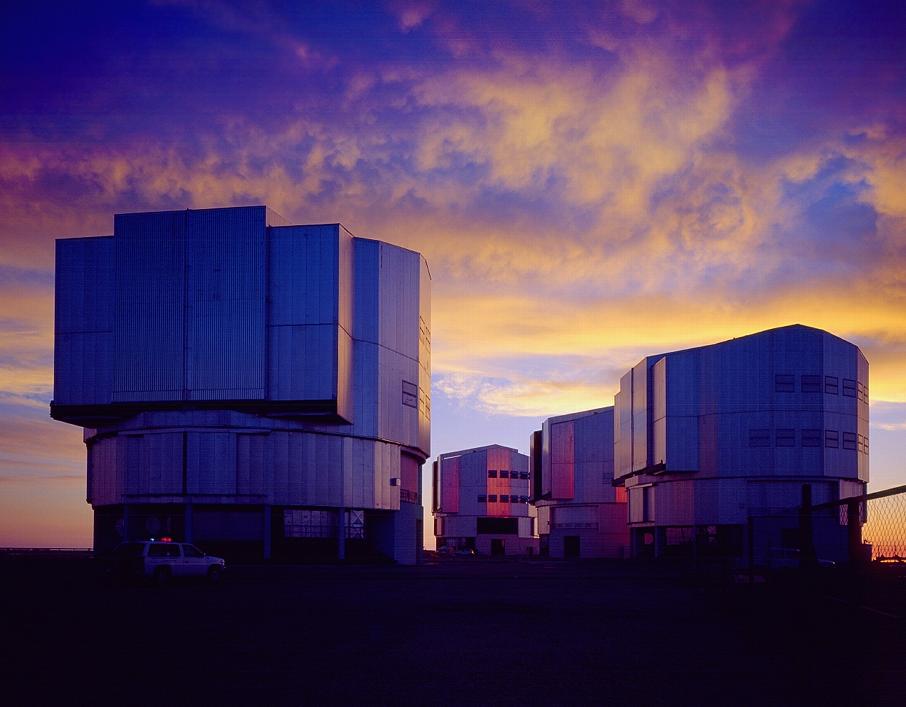Science news

12-May-2008
The distant universe and the English spy
Astronomers on a mountain-top in Chile, where scenes for the next James Bond movie are being filmed, have been spying on the distant universe.
Cerro Paranal is a 2600m mountain in the Atacama Desert, one of the driest places on Earth. A landscape of bare red rock and sand makes it look more like Mars than South America. But the skies are clear here and the air is clean. So this is where ESO - the European Organisation for Astronomical research in the Southern Hemisphere - built its Very Large Telescope (actually four different telescopes). And this is where astronomers from around the world come to live and work and study the stars.
But great conditions for astronomy make it hard for humans at Paranal. Almost nothing can grow here. Humidity is extremely low. Intense ultraviolet rays from the sun are a constant danger and the high altitude makes it hard to breath.
While telescopes can survive on the mountain-top under their metal domes, humans need more comfort and protection. So an air-conditioned “Residencia” has been built a few hundred feet below the peak. Here the scientists and other workers can escape from the harsh, desert after a hard night's work, breathe moist air, and relax in the tropical garden, at the cinema, or by the side of the swimming-pool under its high domed roof.
Scientists from many countries come to Paranal. The team that made this latest discovery consists of two French astronomers - Cédric Ledoux and Patrick Petitjean - and one from India, Raghunathan Srianand. It's a group that has worked closely together before.
In December 2000 they published an important paper on the first measurement of the temperature of the cosmic microwave background radiation, when the universe was young.
The same team has now made the first measurement in an ancient galaxy of three molecules that are often found in the space between the stars of much younger galaxies. These molecules are normal and deuterated molecular hydrogen (H2, HD) and carbon monoxide (CO).
“This is the first time that these three molecules have been detected in absorption in front of a quasar, a detection that has remained elusive for more than a quarter century,” says Ledoux.
The scientists used the UVES instrument on ESO’s VLT to study a well-hidden galaxy whose light has taken almost 11 billion years to reach us. That is four-fifths of the age of the universe.
Astronomers describe this galaxy as follows: "It is a damped Lyman-α system (DLA) at zabs = 2.41837 toward SDSS J143912.04+111740.5."
The galaxy is so distant that the only way the astronomers knew it was there was by its effect on light passing through it from a quasar that's even further away.
Interstellar clouds of gas in the galaxy absorb parts of the light given out by the quasar, explains Raghunathan Srianand. He led the team making the observations. "The resulting spectrum consequently presents dark ‘valleys’ that can be attributed to well-known elements and possibly molecules.”
The same team of scientists had already broken the record for the most distant detection of molecular hydrogen in a galaxy. This galaxy is so far away that we see as it was when the universe was less than 1.5 billion years old.
Interstellar gas is the stuff that stars are made from. So it is an important and very interesting part of galaxies. The behaviour of the molecules in this interstellar gas strongly affects the birth of stars. So detailed study of these molecules is an important tool in understanding the origins of stars and galaxies.
An important finding of this new research is that the conditions of the interstellar gas in this galaxy, far away and long ago, are very similar to those that exist today in our own galaxy.
Another important advance is that the scientists were able to measure, more precisely than ever before, the temperature of the cosmic background radiation in the early universe. “Unlike other methods, measuring the temperature of the cosmic background using the CO molecule involves very few assumptions,” says co-author Pasquier Noterdaeme.
If the universe was formed in a Big Bang, the radiation from this primeval fireball should have been hotter in the past. This is exactly what the new measurements show.
“Given the current measured temperature of 2.725 K, one would expect that the temperature 11 billion years ago was about 9.3 K,” says co-author Patrick Petitjean. “Our unique set of VLT observations allows us to deduce a temperature of 9.15 K, plus or minus 0.7 K."
This is in excellent agreement with the theory, he adds.
These successful measurements open up a whole new area of research - interstellar chemistry at high redshift, says Srianand. "It demonstrates that it is possible, together with the detection of other molecules such as HD or CH, to use interstellar chemistry to tackle important cosmological issues.”
And the James Bond connection?
The Residencia at Paranal caught the eye of the director of the new movie, Quantum of Solace, says its producer, Michael G. Wilson: "It is a true oasis and the perfect hide-out for Dominic Greene, our villain, whom 007 is tracking in our new James Bond film."
Quantum of Solace will be released in the UK in October and internationally in November.
The scientists' results have been published in a Letter to the Editor in Astronomy and Astrophysics (“First detection of CO in a high-redshift damped Lyman-a system”, by R. Srianand et al.).
More help with words
| absolute zero | atom | combined | compact | deuterium | element | elecromagnetic waves | explosive |
| fertile | gravity | isotope | neutron | nucleus | particle | proton | radiation |
What's it all about?
- Where have the astronomers been working?
- Why is the Atacama Desert a good place to do astronomy?
- Why is it not such a great place for humans?
- So what has ESO built there, besides the telescopes on top of the mountain?
- State two things the scientists can do there to relax after their work.
- How long is it since the same group of scientists published another important paper on the cosmic microwave background radiation?
- The three molecules have been detected in space before. What is so different about this time?
- The molecules of gas are in the space between the stars of a galaxy that is so far away that it can't be seen. How do the scientists know it is there?
- The clouds of gas in the galaxy absorb some colours in the light passing through from the quasar. What does this do to the light?
- Different gases absorb different colours. So by looking at the colours that are missing, when the light gets to Earth, scientists can tell what?
- Why is interstellar gas interesting?
- The new research shows that what was going on 11 billion years ago in this distant galaxy was very like what is going on today where?
- Scientists believe the universe began in a Big Bang, and that radiation from that huge explosion has been zipping around ever since, growing steadily cooler as time passes. In what way does this new research support this picture?
- The scientists say their work now opens up a whole new area of research – interstellar chemistry at high redshift. Explain in your own words what this means and why it would be useful and interesting.

